

Scotland whisky tour 29 Sep-05 Oct 2011
Day 1: Loch Lomond Distillery
Scotch Whisky Tour September-October 2011.
Two days before my arrival in Scotland, due to maintenance work, I had to cancel my visit to Deanston distillery, one of the few distilleries that I have not yet visited. Things started to look even worse when in the morning of September 29th, my appointment at Loch Lomond distillery was to be re-arranged. Well, since it occurred on the same day I was supposed to visit Deanston, the appointment was postponed to the early afternoon.
Thursday:
After some difficulties, I managed to find my way to Loch Lomond distillery (http://www.lochlomonddistillery.com/) where I was welcomed by Gavin Durnin, Director, sales and marketing manager at Loch Lomond Distillery Company limited.
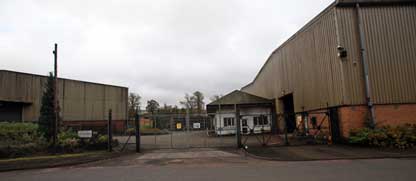 |
| One of the first view of the Loch Lomond Distillery perimeter. |
Loch Lomond is a rather unknown distillery and often considered by some malt whisky “connoisseurs”. As mentioned to me by Gavin, the objective of the company is necessarily to produce the most characterful malt, but one that might suit a wide range of palate (i.e., easy drinking whisky). With marketing expenses of about £0 per year for their Loch Lomond malts and High Commissioner blend, respectively number 2 in Germany and number 5 in United Kingdom respectively, quality should not be that bad? In addition to their whisky activities, their vodka Glensvodka is n°1 in UK, outselling Smirnoff!
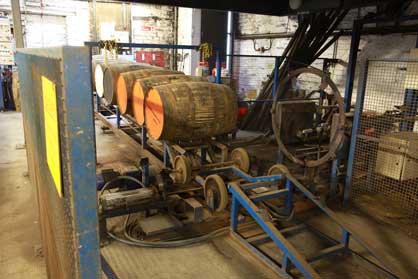 |
| Inside the cooperage: the charring station. |
To me, Loch Lomond has always been an enigmatic and very discreet company that attracted my curiosity and I was more than pleased to have Davin available for a question and answer session lasting more than 1h. My first question was about the structure of the company and their relationship with Glen Caterine bonded warehouse. Contrary to my understanding, Glen Caterine Bonded Warehouse Ltd is not the mother company of Loch Lomond but one separate entity of the Bulloch family. In the 1940s, the Bulloch family opened a retailing shop selling diverse spirits (e.g., Port and whisky). Later on, they decided to expand their spirit activity and the original shop is still in the hand of the founder family. On the other hand, their other activities further developed and includes several business including National Food Beverage, Glen Caterine (e.g., bottling and distribution of blended whiskies), Loch Lomond distillery (that manages Glen Scotia).
From a production point of view, Glen Caterine and Loch Lomond are almost self-sufficient and only do some reciproque trading mainly with the largest drink company of the world.
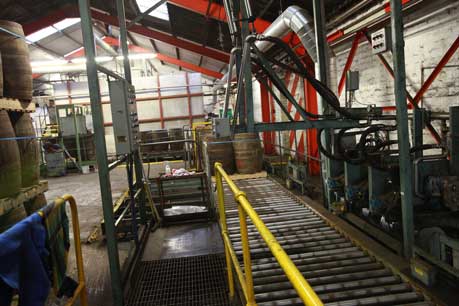 |
| The automated emptying-filling cask station. |
Before moving to the Loch Lomond distillery and its products, I took the opportunity to ask a few questions about the other distillers owned by the Bulloch: Glen Scotia and Littlemill. With the later, no special plan of bottling are planned and although Littlemill stopped production in 1992, the Littlemill contained in the “12 years old” Littlemill contains now whisky aged at least 20 years!
Talking about the Littlemill 12 YO, this range contains as well a Glen Scotia 12 YO and Inchmurrin 12 YO bottled under the responsibility of Glen Caterine, although Inchmurrin is distilled by Loch Lomond.
You still follow me? As we say in French “’l’exception confirme la règle” (the exception confirms the rule): Loch Lomond is responsible for the production and distillation of their malts and grain whiskies, with the exception of the Inchmurrin 12 YO bottled under the responsibility of Glen Caterine.
 |
| Inside one of the warehouses, 7 casks high. |
Of note, this Glen Scotia was from the “old production” (i.e., previous owner) and the quality and variability of the spirit has greatly improved since Loch Lomond took over Glen Scotia distillery 11 years ago. Contrary to some information available on some websites, Glen Scotia did not receive the help from the Springbank staff to perform some small production batches. In fact, some employees from Springbank were made redundant once operation at Springbank distillery went down (mothballed) in the 1980s and were hired by Glen Scotia distillery. The production process was not “guided” and directed by the ex-Springbank staff, but by the Loch Lomond distillery. Thank you Gavin for the clarification. According to Gavin, the quality of the spirit at Glen Scotia has improved under their ownership.
So what about the Distillery Select range? Gavin was the originator of this new range consisting of single cask whiskies, non-chill filtrated, without colouring and bottled at 45%. This range is bottled under the supervision of the Loch Lomond distillery and the casks are selected by the Bond Manager, the Distillery Manager and Gavin. The whiskies are normally aged between 5 and 8 years and bottled in green glass bottle. A selection of single casks will be released very soon, with a new clear bottle. Amongst the new selection, four new Glen Scotia will be released, 2 normal and 2 peated version, aged between 4 and 11 years. Tasting notes will be produced shortly on www.whisky-news.com.
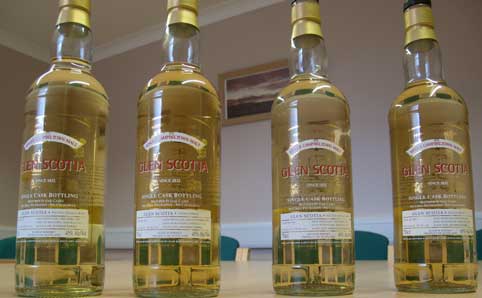 |
| The new Glen Scotia Distillery Select range |
After this started, time for the main course: the Loch Lomond whiskies.
The range consists of the non-aged specified, a 18 years old that replaces the 21 YO, the single blend and peated Loch Lomond (composed of different whiskies distilled at Loch Lomond distilleries, including Croftengea). By definition, a single malt is defined by the product of 1 distillery. If a distillery produces different “variants” and you vat them together, the final product remains a single malt.
 |
| The malt distillery (left) and the grain distillery (right). |
Loch Lomond distillery has a rather special, unique and confusing structure for the neophyte (and not only!). Loch Lomond distillery has two sites at Alexandria (one with warehouses and cooperage and another one with the distilleries) and two distilleries (one grain and one malt distillery), and within the grain distillery, they have 4 sets of stills: 2 sets with rectifying heads (a variant of Lomond Stills), 1 set of normal pot stills and 1 set of continuous stills for malt.
This unique combination of stills allows Loch Lomond to produce several makes (whiskies) with different flavour profiles. This is enhanced furthermore by using peated and non-peated barley.
The following products are then distilled:
Single grain whisky made with 100% malt:
Rhosdhu: A” single grain whisky made with 100% malt” (thanks to the new regulation, this “single malt” distilled in a continuous still cannot be called “single malt”) produced since December 2007. This is used a malt for blends and the current production volume is 2 mio litres of pure alcohol (2 mio LPA). Of note, this “Rhosdhu” should not be confounded with the single malt distilled until 2002 by Loch Lomond distillery!
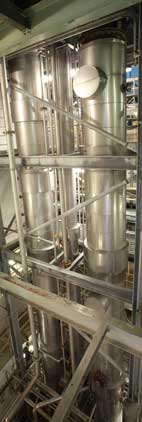 |
| The continous stills used for the production of whisky made with 100% malt (Rhosdhu). |
Single malts:
Several single malts are produced at Loch Lomond, with a total production of 2 mio LPA, divided almost equally between Inchmurrin, Loch Lomond and Glen Douglas. The peated malts represent a small proportion of the total malt produced.
Loch Lomond: The majority of the production is a non-peated whisky, but twice a year, they produce some heavily peated Loch London distillery, at the same time as the peated Inchfad , Graiglodge and Croftengea). This is a pot still whisky distilled with the “normal” pot stills.
Glen Douglas: non-peated malt whiskies produced on the stills with rectifying heads. The volume by alcohol (abv) of the heart of the run is 66%.
Inchmurrin: Similar to the Glen Douglas, but the stills are configured differently and the spirit is recovered at 85% abv.
Inchfad: Malt peated to 25 ppm of phenols, stills with rectifying heads.
Craiglodge: Malt peated to 25 ppm, stills with rectifying heads.
Croftangea: Malt peated to 55 ppm, spirit peated to 65 ppm, stills with rectifying heads.
To complicate the matter even further, Loch Lomond has been experimenting different yeasts. In addition to the M, MX and Anchor dried yeast, they are using wine yeast: a sauvignon blanc yeast contributing to a winey flavour (sweet chardonnay flavour) to the whisky. Since the start of the experiment 5 years ago, a small production is now done on a yearly basis (2x). Of note, the wine yeast is approximately 4x more expensive than the regular distiller’s yeast.
After this rather comprehensive introduction, it was time for the sites and distilleries visits.
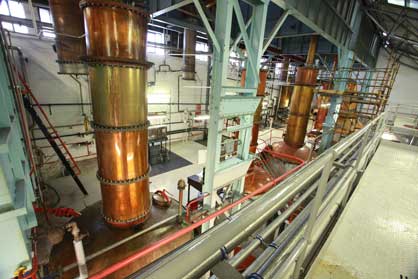 |
| The pot stills, with the traditionnal ones on the bottom righ. |
At Alexandria, Loch Lomond owns over 30 warehouses, racked or palletized. Palettes are up to 7 high. Although they have a storing capacity is 50 mio litres, the warehouses are full and the next investment will be the expansion of their storage capacity. The town of Alexandria expanded since the construction of the distillery in 1966, therefore, a new place needs to be found for them. A cooperage is on site and includes 4 coopers. The staff at Loch Lomond is 53 people. Next door is located a production line allowing the automatic emptying of the cask and refilling. Whisky is not bottled at Alexandria, but at the bottling plant of Glen Caterine in Kilmarnock. The casks are used up to 5 times. With the exception of a few ex-sherry casks, ex-bourbon barrels are the main casks used, with some hogshead and a few quarter casks. A quarter cask is now used for the final maturation of their oldest whisky, a cask of 1967 Loch Lomond. No wine casks are used, with the exception of some wine casks requested for the maturation of their Loch Lomond Organic whisky distilled in 2000 in order to obtain the “organic” label. The next move was at the distilleries site, where eight 50,000 L washbacks for the malt distillery and eight 200,000 L fermenters were recently added outside the distilleries in order to increase the capacity of production in 2007. The two distilleries are physically separated by a common wall. The malt distillery contains a full lauter mash tun, as well as ten 5,000 L stainless steel washbacks sharing the same space as the 4 sets of stills: the original set of 2 stills with rectifying heads (compared to the Lomond still at Scapa, at the top of the neck is placed a metalling ring where water can circulate in order to increase the reflux of the spirit) was commissioned in 1967, followed by a second set in 1985, a traditional pot still set in 1999 and finally a set of 2 columns for the malt in 2007.
The visit to the grain distillery was limited, since all the production steps are fully automated and controlled from a high-tech control room. Unless there is a technical problem, no staff needs to physically present in the production area. The grain whisky produced at Loch Lomond is composed of 10% malted barley and 90% wheat. The analyser is made of stainless steel, while the rectifier is made of copper.
As you might have noticed it, the grain whisky with 100% malt is not produced with the same stills as for the “normal” grain whisky. Apart from the sheer size, the 2 column stills for the malt are made copper and instead of having the sprit running at a predefined strength, sprits is collected at several levels (4) corresponding to different strength ranging between 70 and 90 % abv, thus mimicking the process of a normal pot still where the heart of the run (spirit). The yield for the malt spirit on the column still is the same as for the pot stills, i.e., above 400 LPA/tonne. While we are in the technical details, the fermentation time for the malt production at Loch Lomond is probably the longest in the industry with 180h (this is not a typo!).
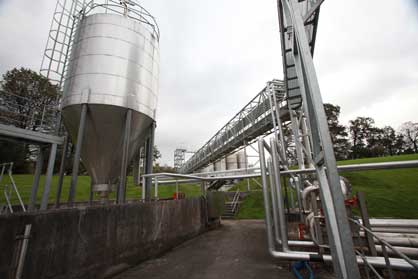 |
| The water treatment plant and the external fermenters. |
In the laboratory, I nosed and then tasted blind several samples of 3 years old whiskies reduced all at the same drinking strength. The first sample was a smooth, malty, slightly fruity, but otherwise rather neutral (Inchmurrin), followed by a more complex, fruitier (more on peach) Glen Douglas and finally by a smooth, fruity, slightly nutty and spicy Loch Lomond. The grain whisky was rather neutral, slightly coarse to my taste, with some freshly crushed cereal notes. The Croftengea tasted more like a medium peated whisky than a whisky with almost twice the phenolic level of a Caol Ila for example. The Croftengea was a surprisingly sweet, smooth and fruity whisky without any dryness or maritime flavours associated with an Islay whisky for example. If you like peat but not the dryness on an Islay whisky, then you might want to taste this whisky. My biggest surprise was probably the Rhosdhu. When I tasted the Rhosdhu, I thought I tasted a 20 years “old Rhosdhu”, not a 2.5- 3 year grain whisky (spirit) with 100% malt content! It was a remarkably complex, well balance, rich, spicy, intense, fruity, with some malty and slighty nutty notes and short to medium very smooth finish. Something very different from the Japanese Coffey malt whiskies or from any grain whisky. It is in no cases an inferior whisky. It is of the same quality as other single malts, since the sample I enjoyed the most in the lab.
While the promotional budget is negligible, I was surprised by the general appearance of the distillery, filled with all the latest technologies and extensive energy saving and recovery system. Over the last years, energy expenditures have been reduced by almost 50% and water consumption by 75%. Loch Lomond is probably one of the greenest distilleries around. Instead of putting lots of money in marketing, they invest heavily in their distillery(ies).
Loch Lomond might be very discreet, but it is a highly innovative distillery (sometimes too much for certain?) producing whiskies appealing to the largest range consumer instead of producing Super premium whiskies appealing to a limited group of connoisseurs.
A limited edition of 1800 bottles of Loch Lomond 1966 whiskies to be launched in October in Germany, at the same time as the movie “Tintin” will be in the European Theatres (as the Tintin’s reader might know, the Loch Lomond whisky was the favourite whisky of Captain Haddock).
After 4 hours spent at Loch Lomond distillery, I was time to take my leave and to head towards my next destination: Menstrie. I wish to thank Loch Lomond distillery, Gavin and all the staff for a memorable visit at their distilleries. Of note, the distillery is unfortunately not opened to the public.
www.whisky-news.com ©16 Oct 2011